Table of contents
- Comparison test Kawasaki Ninja ZX-6R, Triumph Daytona 675, Yamaha YZF-R6 Three 600 athletes in comparison
- 600 series test on the race track in Calafat
- Changes to the previous year’s models
- The 600s in detail
- Lap times on the race track in Calafat
- Driving impression of the Yamaha YZF-R6
- Driving impression Triumph Daytona 675
- Driving impression Kawasaki Ninja ZX-6R
- Lap times and data recording
- Conclusion
- Horsepower rating Kawasaki Ninja ZX-6R
- HP rating Triumph Daytona 675
- HP rating Yamaha YZF-R6
- Technical data Kawasaki Ninja ZX-6R
- Technical data Triumph Daytona 675
- Technical data Yamaha YZF-R6
- Racing tires: Bridgestone BT 003
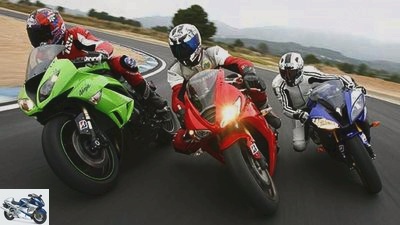
Fact
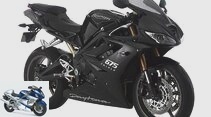
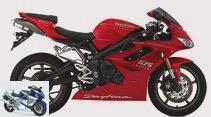
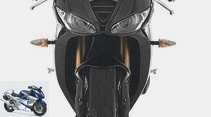
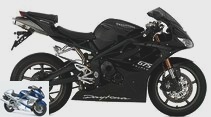
9 pictures
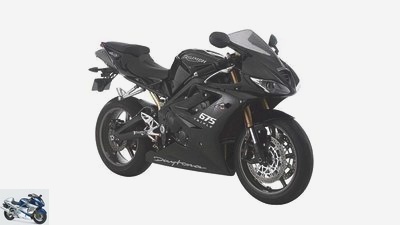
triumph
1/9
Triumph Daytona 675

triumph
2/9
Triumph Daytona 675
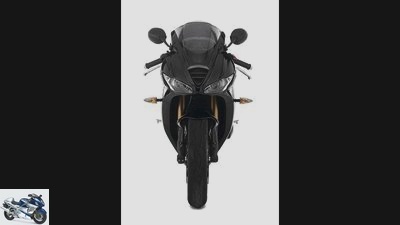
triumph
3/9
Triumph Daytona 675
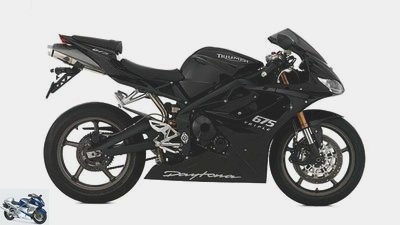
triumph
4/9
Triumph Daytona 675
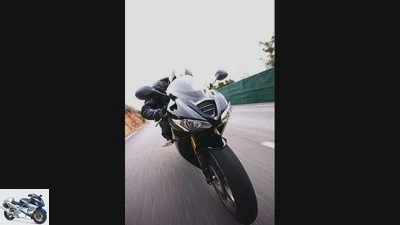
triumph
5/9
Triumph Daytona 675
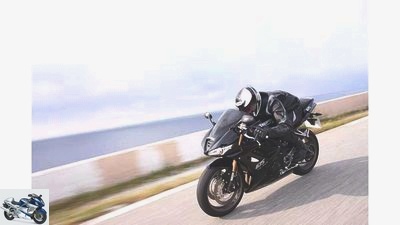
triumph
6/9
Triumph Daytona 675
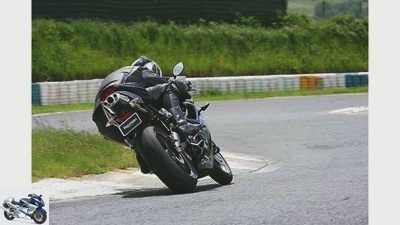
triumph
7/9
Triumph Daytona 675
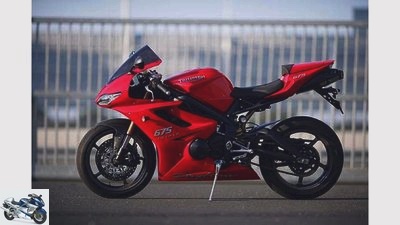
triumph
8/9
Triumph Daytona 675
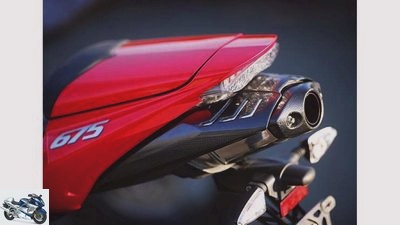
triumph
9/9
Triumph Daytona 675
motorcycles
Comparison test Kawasaki Ninja ZX-6R, Triumph Daytona 675, Yamaha YZF-R6
Comparison test Kawasaki Ninja ZX-6R, Triumph Daytona 675, Yamaha YZF-R6
Three 600 athletes in comparison
Content of
The three 600s from Kawasaki, Triumph and Yamaha were born for the racetrack. This track test clarifies the pecking order.
Robert luck
03/18/2009
600 series test on the race track in Calafat
Two new, sometimes more, sometimes less heavily revised super athletes alias Kawasaki ZX-6R and Triumph Daytona 675 meet the established Yamaha YZF-R6. They have uniform Bridgestone tires and IDM racing driver Arne Tode in their luggage.
The meeting point is the race track in Calafat near Barcelona, where a lot has changed since last year: The undulating asphalt, the knee-high curbs and the coarse gravel beds are a thing of the past; even surface, flatter curbs and new gravel beds.
Changes to the previous year’s models
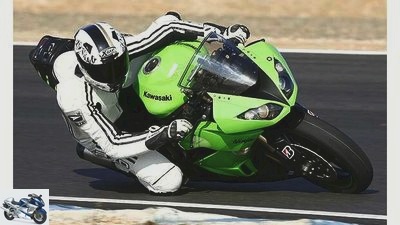
Fact
The 2009 ZX-6R is reminiscent of its 1000 cc sister, the ZX-10R.
Kawasaki ZX-6R
For 2009, the Kawasaki engineers have turned the overweight ZX-6R into a much more delicate motorcycle: 10 kilograms lighter, equipped with a Big Piston Fork from Showa, and looks a lot like its big sister, the ZX-10R and revised the engine sustainably. If the three test candidates are close together, it works Kawasaki yet powerful, less wiry than the other two.
Triumph Daytona 675
The Triumph has been visually and technically revised. “Fine tuning” call it some, “Small Step Policy” the others. The British donated the Daytona 400 rpm more revving power, 3 HP more peak power and a 3 kilogram lower total weight.
Yamaha YZF-R6
The unchanged Yamaha YZF-R6, the optically most ascetic and radical of the trio, gets the red lantern on the scales: its 192 kilograms contrast with 190 kg from Kawa and 675. The Yam countered calmly: She massaged her rear tire with 116 HP on the asphalt, neither of the other two has that much power.
The 600s in detail
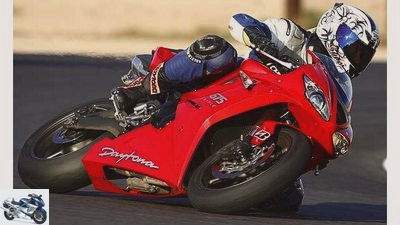
Fact
The exterior of the Triumph Daytona 675 was only slightly retouched for 2009.
Triumph Daytona 675
On the 675, the compression damping of the shock absorber and fork can now be adjusted separately for the high and low-speed ranges.
The latest generation of Nissin brake calipers is working on the Triumph fork: These monoblocks, made from one piece, are intended to provide an even better braking feel and hold two pads per caliper.
The tires prove how important Triumph Grip and feedback are on the 675: The new Pirelli Diablo Supercorsa in street legal “SP”-Variant is honored.
Kawasaki Ninja ZX-6R
The Kawasaki relies on the Bridgestone BT 016, which is more suitable for everyday use, with a special specification “L.” and comes up trumps with the brakes: It also has the new monoblocks from Nissin, but in the more complex version with individual pads, i.e. four pads per pliers.
Yamaha YZF-R6
The test copy of the R6 also carried Bridgestone BT 016 tires in the “F.”-Variant; the previously traditionally raised series skins, the suboptimal Dunlop qualifiers, had disappeared.
Lap times on the race track in Calafat
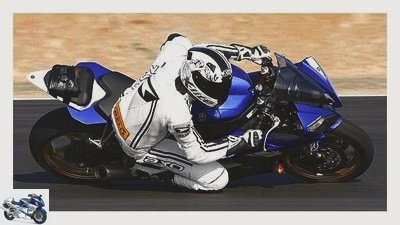
Fact
Everything about the Yamaha YZF-R6 has a purpose or is not there.
Against the clock
As I said, the stretch in Calafat, Spain, was re-asphalted at the end of last year and was a little wider in places. Even we couldn’t predict how that would affect the lap times. One could have guessed, however, that Arne Tode, as IDM Supersport Champion 2008 on an old Triumph Daytona 675, would have a certain training advantage over the competition.
Another factor that influenced the lap times were damp spots on the track. In the first turn on the Yamaha, Arne didn’t know exactly how much grip he would have there. This disadvantage should have been offset by a second turn, but we didn’t have the time and the weather didn’t play well.
Annoying, but in PS 4/2009 there is a large 600 series comparison test with all Japanese and also with lap times from Calafat ?? under more comparable conditions.
Driving impression of the Yamaha YZF-R6
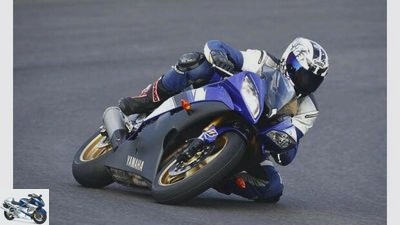
fact
The most consistent race track 600 is the Yamaha YZF-R6.
the Yamaha YZF-R6 is a lightning-fast motorcycle, but also a radical, closed and above all very demanding one; the pilot has to work out an R6. Her greedy turning behavior is open to everyone, but using it effectively takes practice.
Your powerful engine has a top performance characteristic, also that a special trait that is initially deterring, rather it makes it fast. If the course does not fit, you will be nibbled; if the passage fits, you tear everything down.
The data recording explains how harsh the R6 is. In the Omega, Tode drives the slowest cornering speed on the R6 because he doesn’t trust the grip on the damp spots.
After the apex on a dry track, however, he pulls the cable fully. Despite the lowest basic speed, the Yamaha managed the sprint from 75 to 180 km / h over a distance of almost 200 meters in 4.6 seconds.
The higher-torque Triumph loses a tenth of a second in this action alone, the Kawasaki even two. At only 198 meters!
However, what did not fit into the image of the hot hunter R6 were the tired brakes of the test model and its hard throttle response.
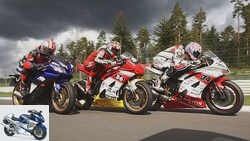
motorcycles
Comparison test: Yamaha YZF-R6 in three expansion stages
R6 series vs. Cup vs. IDM bike
read more
Driving impression Triumph Daytona 675
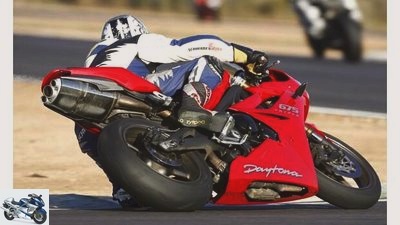
fact
The three-cylinder engine of the Triumph Daytona 675 is fascinating.
In these disciplines, the Triumph Daytona 675 fully. Your Nissin brakes bite strongly, but in a controlled manner, the three-cylinder engine gently accelerates and presses evenly. The higher maximum speed gives the treble the necessary overspeed reserve and multiplies the fun.
Only the hard-shifting gearbox remains to complain about, and the missing slipper clutch is on the wish list for the next generation of the 675.
The handling and the balance of the Englishwoman stand out. It’s an anti-stress bike, electrifying the driver, but not forcing him to do anything. Rather, it always lures him a little further to his limit; spreads relaxing joy in fast drivers, no pressure to perform.
Driving impression Kawasaki Ninja ZX-6R
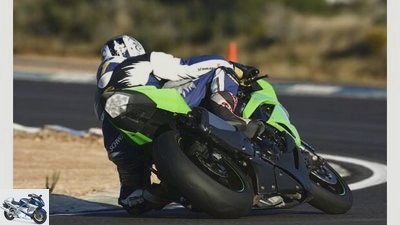
fact
The Kawasaki Ninja ZX-6R offers ample pressure over a wide speed range.
the Kawasaki Ninja ZX-6R pays more attention to suitability for everyday use than to the last tenth of a second. Nevertheless, it is doing very well in Calafat: its engine is running really well. Its lush pressure between 6000 and 10000 rpm forgives one or the other shifting error. Above 14,000 rpm, however, it feels poor.
However, the six in the test struggled with chattering, which mainly occurred with the racing tire. Even a softer rear tire (type 4) brought little relief. Therefore, the somewhat daring but practicable suspension setting had to support Mr. Tode on the fast lap: The fully closed rebound stage on the shock absorber somewhat interrupted the vibrations and alleviated the symptom. However, the Kawa also ran a little more arcs at the exit of the curve and did not drive as precisely and precisely as Triumph and Yamaha.
The data recording brought some remarkable things to light. The most unwieldy 600 of the test rushed through the fast chicane the fastest. Yes, the Kawasaki Ninja ZX-6R burned through the alternating curve with 114.7 km / h, the Yamaha with 114.5 and the Triumph with 114.0. Of course this is not a world, not even a small one, but it is remarkable. So handiness begins where the pilot’s strength ends.
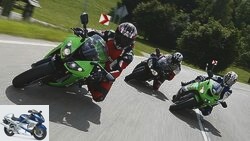
motorcycles
Old versus new: Kawasaki ZX-10R
Super ninjas
read more
Lap times and data recording
What a professional racing driver can achieve with these little rockets is impressive: Driving a 1: 31.40 min in Calafat with 111 rear-wheel horsepower is a high level of craftsmanship ?? and by the rider and designers of the motorcycle. This lap time was 4.1 seconds faster than the best time of the previous year (see PS 4/2008).
Thanks to 2D data recording, a lot of data from Arne death’s fast laps is available. The big time difference between the best times is due to a disadvantage in training with the Yamaha YZF-R6: With it, Tode was the first to go on the track littered with damp spots and first had to feel his way to the limit.
Conclusion
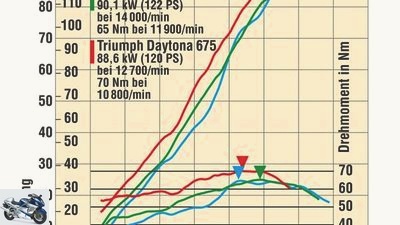
Power and torque diagrams for Kawasaki Ninja ZX-6R, Triumph Daytona 675 and Yamaha YZF-R6.
In PS 4/2009 the everyday aspect of the new six hundred will play a role. So it remains exciting, even if in the select circle of Kawasaki ZX-6R, Triumph Daytona 675 and Yamaha YZF-R6 the die is cast on the racetrack.
Lap times are not everything, they just give an impression of what the hardware can do. The victory of the Triumph Daytona 675 fine with me. It is the best package for stress-free speeding and hardly ever makes mistakes. the Yamaha YZF-R6 is a racing pig and takes second place. Hardly a bike is more aggressive and demanding. The third is for them Kawasaki Ninja ZX-6R is not a defeat, but worthy of all honor: She is generally very good and peaceful, far from the previous one “mean green”. She lacks the kick, the character of the two opponents.
Horsepower rating Kawasaki Ninja ZX-6R
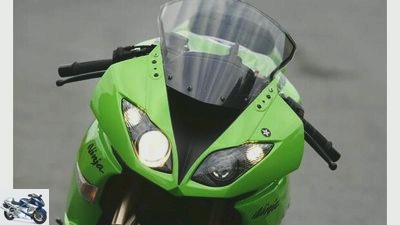
fact
In fact lighter, visually bulky: Kawasaki Ninja ZX-6R.
Kawasaki ZX-6R: 3rd place (17 points)
drive *****
The Kawa accelerates gently, has a super slipper clutch and a lot of pressure in the middle. Upstairs should be happy
go a little more.
landing gear ***
The ZX-6R was plagued by chattering and went a bit far at the corner exit. In addition, it requires the most force when killing in harassment.
ergonomics *****
The new Ninja offers its pilot plenty of space and proper wind protection. It is very good for burning because people sit together.
Driving fun ****
The kawa has lost 10 kilos. Nonetheless, she’s not nearly as agile as the other two, which tarnishes the fun a bit and costs strength on the track.
verdict
The ZX-6R has become slimmer and lighter. However, it still has to increase in agility and precision in order to be fully involved with the music.
HP rating Triumph Daytona 675
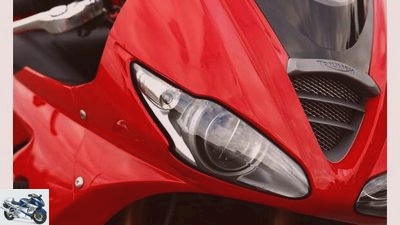
fact
Slight optical retouching for 2009: Triumph Daytona 675.
Triumph Daytona 675: 1st place (19 points)
drive ****
The only criticisms of the 675 are the lack of an anti-hop clutch and the bony gearbox. Otherwise a great engine.
landing gear *****
This unbelievable precision, their greedy turning behavior and the cornering stability make them a dream on a lean angle.
ergonomics *****
The Triumph is a real racer. She accommodates her driver in a very collected and sporty manner, who has a very good feel for the front wheel.
Driving fun *****
Being different can be good or bad. In the case of the 675, it’s good, because three-cylinder and razor-sharp handling are only available from England.
verdict
Again the champion is the triumph. Your moderate revision has been carried out in the right places, has made very good things even better.
HP rating Yamaha YZF-R6
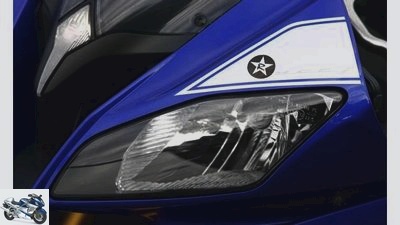
fact
The aggressive front end of the Yamaha YZF-R6.
Yamaha YZF-R6: 2nd place (18 points)
drive ****
The R6 four is very pointed and has no thump underneath; you can adjust to that. The hard throttle response of the test bike was annoying.
landing gear ****
The Yam rides the front wheel like a champion. Unfortunately, the somewhat too conservative brakes at the entrance to the corner are a nuisance.
ergonomics *****
What a playground this Yamaha is: It offers a lot of space for gymnastics and always offers the pilot a very sporty workplace.
Driving fun *****
If all the pieces in the R6 puzzle fit, there is no stopping them. No foursome roars louder and turns wilder, no Japanese kills faster than she does.
verdict
On the race the yam is a power. Unfortunately, her brakes and the hard throttle response couldn’t keep up with the winner.
Technical data Kawasaki Ninja ZX-6R
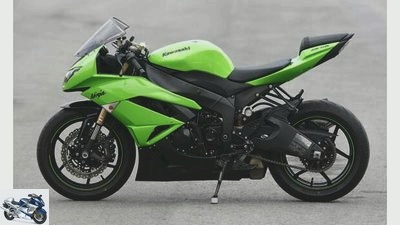
fact
Kawasaki Ninja ZX-6R.
| Kawasaki Ninja ZX-6R |
Technical data Triumph Daytona 675
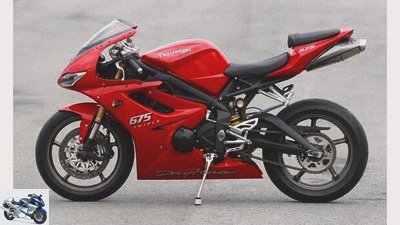
fact
Triumph Daytona 675.
| Triumph Daytona 675 |
Technical data Yamaha YZF-R6
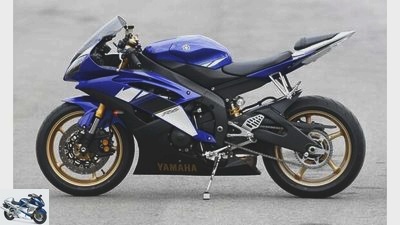
fact
Yamaha YZF-R6.
| Yamaha YZF-R6 |
Racing tires: Bridgestone BT 003
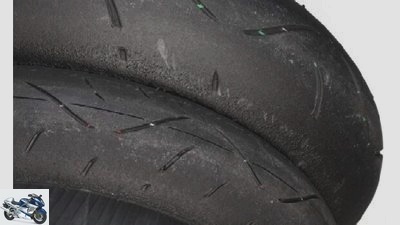
mps studio
We set the test lap times on Bridgestone BT 003 racing tires.
For the comparison test, Bridgestone donated three sets of BT 003 in Type 4 (soft) for the front and Type 3 (medium) for the rear. A total of 3 compounds are available for the front and rear, Type 2 is the hardest.
In Calafat, the rubbers were particularly convincing due to their fat grip at a very high level, which hardly decreased over the entire day. Only Arne Tode noticed that the BT 003 degrades a bit after a few very quick laps, but then maintains its level of grip.
The BT 003 made a lasting impression with its stability: on the Yamaha YZF-R6 he put away 63 rounds without giving up or tearing up. respect!
Related articles
-
Honda CBR 600 RR, Kawasaki Ninja ZX-6R, Suzuki GSX-R 600, Triumph Daytona 675, Yamaha YZF-R6
Jahn 15th pictures Honda 1/15 For the model year 2009 Honda presents a facelifted CBR 600 RR. The well-known 600 cubic four-cylinder has been trimmed for…
-
fact motorcycles Comparison test: Honda CBR 600 RR, Kawasaki ZX-6R, Suzuki GSX-R 600, Triumph Daytona 675, Yamaha YZF-R6 Comparison test: Honda CBR 600…
-
Comparison test Ducati 1098S, Honda Fireblade, KTM 1190 RC8, Triumph Daytona 675, Yamaha YZF-R6
Jahn motorcycles Comparison test Ducati 1098S, Honda Fireblade, KTM 1190 RC8, Triumph Daytona 675, Yamaha YZF-R6 Comparison test Ducati 1098S, Honda…
-
Bilski motorcycles Comparison test: KTM 990 Super Duke, Moto Morini Corsaro 1200 Veloce, Triumph Speed Triple, Yamaha FZ1 Comparison test: KTM 990…
-
Concept comparison: Kawasaki, Triumph, Yamaha
K motorcycles Concept comparison: Kawasaki, Triumph, Yamaha Concept comparison: Kawasaki, Triumph, Yamaha Fabric for Zoff Content of The liter is a handy…
-
Comparison test: Yamaha YZF-R6 in three expansion stages
Jahn motorcycles Comparison test: Yamaha YZF-R6 in three expansion stages Comparison test: Yamaha YZF-R6 in three expansion stages R6 series vs. Cup vs….
-
Jahn 31 pictures Photos: fact / Jahn 1/31 Honda Fireblade, Kawasaki Ninja ZX-10R, Suzuki GSX-R 1000, Yamaha YZF-R1, Ducati 1198S, KTM 1190 RC8 R and…
-
Comparison test: Honda Hornet, Kawasaki Z 750, Suzuki GSR 600
Jahn motorcycles Comparison test: Honda Hornet, Kawasaki Z 750, Suzuki GSR 600 Comparison test: Honda Hornet, Kawasaki Z 750, Suzuki GSR 600 ABS shooters…
-
Honda Fireblade, Kawasaki Ninja ZX-10R, Suzuki GSX-R 1000, Yamaha YZF-R1
fact 28 pictures Honda 1/28 Honda 2/28 Honda 3/28 Honda 4/28 Honda 5/28 Honda 6/28 Honda 7/28 Honda 8/28 Honda 9/28 Honda 10/28 Honda 11/28 Honda 12/28…
-
Single test: Kawasaki Ninja 300
Kawasaki motorcycles Single test: Kawasaki Ninja 300 Driving report: Kawasaki Ninja 300 More bite: the new Kawasaki Ninja 300 in the test More…